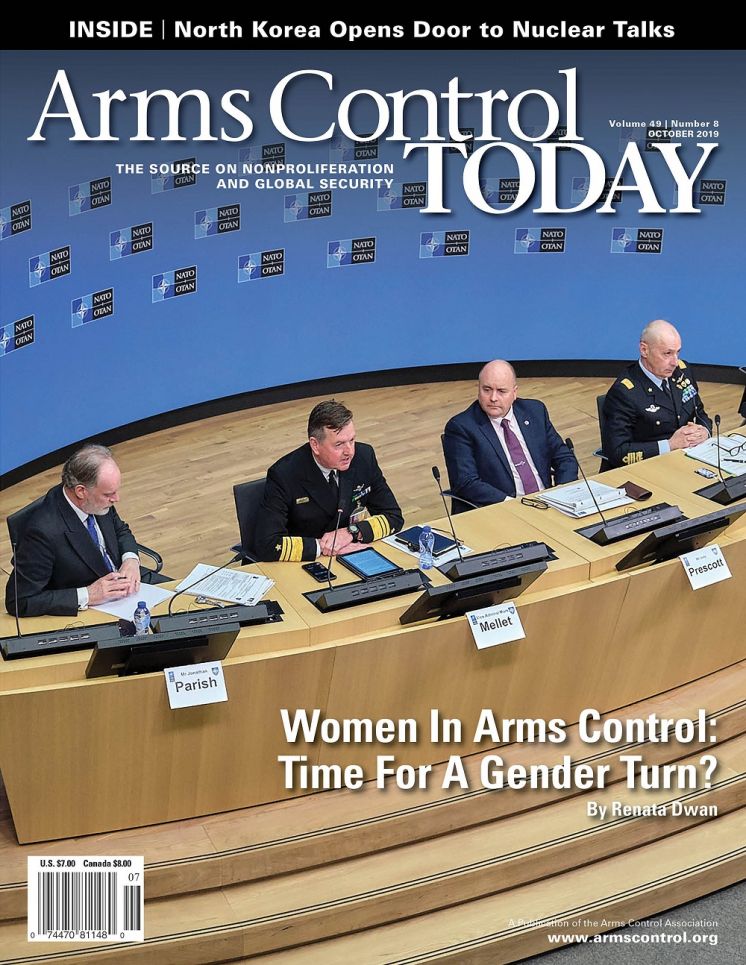Arms Control Today, News in Brief, October 2019
The publication of the News in Brief section of Arms Control Today magazine is a joint project of the Center for International Security and Policy and The Arms Control Association.
India Boosts Range of BrahMos Cruise Missile
India has increased the range of its BrahMos supersonic cruise missile to 500 kilometers after successful summer testing, an industry official told The Economic Times. The technological development followed earlier reports that New Delhi may soon begin exporting the missile to the Middle East and Southeast Asia. The conventionally armed BrahMos missile is reported to be world’s fastest cruise missile, capable of flying at nearly three times the speed of sound. It is manufactured in India by BrahMos Aerospace, a joint Indian-Russian enterprise.
The new capability was made possible by India’s membership in the Missile Technology Control Regime (MTCR), said Sudhir Kumar Mishra, the firm’s chief executive officer. Before joining in 2016, India was prevented from receiving technology from MTCR members, such as Russia, for missiles capable of flying more than 300 kilometers or carrying payloads heavier than 500 kilograms.
MTCR limitations will need to be considered as India decides which versions of the BrahMos to export.
Thailand, Singapore, and Malaysia have expressed interest in the BrahMos, according to Sputnik News, and other customers friendly to India and Russia may also be interested. – JULIA MASTERSON
India Considers No-First-Use Changes
India may be considering repudiating its long-standing no-first-use nuclear doctrine, according to an Aug. 16 tweet by Indian Defense Minister Rajnath Singh. “India has strictly adhered to this doctrine,” Singh wrote, but “what happens in the future depends on the circumstances.”
Like China, India currently vows to use nuclear weapons only in retaliation for a first-strike attack. If there is a change, it would not be the first time that India has modified its nuclear posture. India adopted a no-first-use policy in 1998 but stipulated that the promise extended only to states that did not have nuclear weapons and were not aligned with a nuclear-armed state (See ACT, July/August 1999). In 2003, India formally published its nuclear command structure and reaffirmed its no-first-use policy, but added that a chemical or biological attack could warrant a retaliatory nuclear response, further conditioning the scope of its 1998 pledge. (See ACT, January/February 2003.)
The incumbent Bharatiya Janata Party (BJP) promised in 2014 to amend India’s nuclear doctrine, and specifically to revisit the no-first-use issue. (See ACT, May 2015.) The same promise was notably absent from the BJP 2019 manifesto, but the recent comments come from the highest-ranking official to have hinted at additional adjustments to New Delhi’s nuclear use policy. – JULIA MASTERSON
Four Candidates Vie to Lead IAEA
The International Atomic Energy Agency (IAEA) announced in September that it has received four nominations of candidates to become the agency’s sixth director-general. The four are seeking to succeed Yukiya Amano of Japan, who died in office on July 18, midway through his third term. (See ACT, September 2019.)
The candidates are Cornel Feruta of Romania, Rafael Mariano Grossi of Argentina, Lassina Zerbo of Burkina Faso, and Marta Ziakova of Slovakia. They are scheduled to meet in early October with the agency’s 35-nation Board of Governors, which must approve a candidate by a two-thirds majority. The board’s selection will then be sent to the agency’s entire membership for its approval, with a goal of completing the selection process by the end of the year.
Feruta is the agency’s acting director-general, stepping up to the post after previously serving as Amano’s deputy. Grossi is Argentina’s ambassador to the IAEA and previously served as the agency’s assistant director-general for policy in the agency. Zerbo is executive secretary of the Comprehensive Test Ban Treaty Organization. Ziakova is chairperson of the Slovak Nuclear Regulatory Authority and has previously chaired the agency’s Board of Governors and General Conference. – GREG WEBB
Pakistan Maintains Missile Tests
Pakistan tested a 290-kilometer-range ballistic missile in late August, soon after a set of clashes between Indian and Pakistani forces in the disputed Kashmir region. The Ghaznavi missile, based on a Chinese design, is reportedly capable of delivering multiple types of warheads, according to an Aug. 29 release from Pakistan’s military, which said it notified Indian counterparts of the test according to the terms of confidence-building measures agreed in the 1999 Lahore Declaration. (See ACT, January/February 1999.)
Pakistan deploys seven nuclear-capable missiles, all of which are also capable of carrying conventional payloads, according to the Missile Defense Advocacy Alliance. Prior to the Ghaznavi test, Pakistan had most recently tested a ballistic missile in May, as India counted its national election ballots, CNN reported.
The Pakistani release said the missile test was part of a field training exercise “aimed at practicing quick response procedures.” – JULIA MASTERSON

